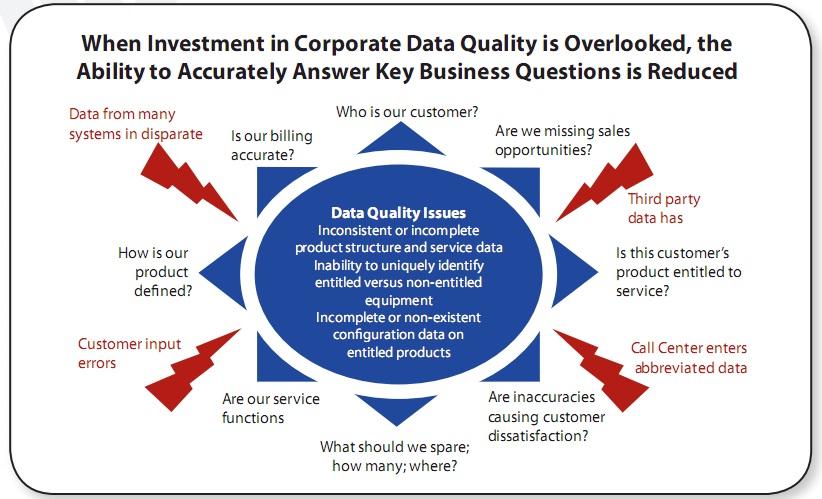By Joe DeSiena, President Consulting Services
Common Problems with Corporate Data
Research has shown the amount of data and information acquired by companies has close to tripled in the past four years, while an estimated 10 to 30 percent of it may be categorized as being of “poor quality” (i.e., inaccurate, inconsistent, poorly formatted, entered incorrectly, etc.). The common problems with corporate data typically fall into the following five major areas:
- Data Definition – typically manifesting itself through inconsistent definitions within a company’s corporate infrastructure.
- Initial Data Entry – caused by incorrect values entered by employees (or vendors) into the corporate database; typos and/or intentional errors; poor training and/or monitoring of data input; poor data input templates; poor (or nonexistent) edits/proofs of data values; etc.
- Decay – causing the data to become inaccurate over time (e.g., customer address, telephone, contact info; asset values; sales/ purchase volumes; etc.). Data Movement – caused by poor extract, transform and load (ETL) processes leading to the creation of data warehouses often comprised of more inaccurate information than the original legacy sources, or excluding data mistakenly identified as inaccurate; inability to mine data in the source structure; or poor transformation of data.
- Data Use – or the incorrect application of data to specific information objects, such as spreadsheets, queries, reports, portals, etc.
Each of these areas represents a potential problem to any business; both in their existence within the organization, as well as the ability of the organization to even recognize that the problem exists. In any case, these are classic symptoms of “data denial” – one of the most costly economic drains on the well-being of businesses today.
Data Quality Maturity Levels
There are five key status indicators used to measure the existing levels of Data Quality maturity in an organization, each with its own set of distinct corporate, and human, attributes. However, it is at the mature level where you will want your organization to be positioned (Figure 1).
The Embryonic level is the least beneficial place to be, as Data Quality does not even appear on the organization’s radar screen; there is extensive finger-pointing with respect to data-associated blame, generally leading to cover-ups and CYAs; and there is no formal Data Quality organization in place. As far as the humans involved in the process are concerned – they are totally “clueless”.
The Infancy level is not that much better, although the organization has begun to consider looking into Data Quality; various ad hoc groups may have been established to search for “answers”; and Data Quality has been positioned as a subset of corporate IT. This typically occurs as the human element begins to show an emerging interest.
The Adolescence level is one of mixed Data Quality accomplishments where most of the pain points have already been identified and the strategy team has shifted into a crisis-driven “full court press” managed by formal Data Quality teams that are populated and coordinated by both IT and the Business. This is also the point where alternating periods of panic and frenzy typically set in.
By the time the organization reaches the Young Adult level, there begins to be some semblance of an evolving Data Quality structure, where the entire organization is involved; one where both IT and the Business have begun to work as partners toward a common goal. Accordingly, the human attribute has also become much more “stabilizing”.
Once the organization has attained the Mature level, it has finally reached the point where it has implemented an effective Data Quality structure, characterized by collaborative efforts and Data Quality/Center of Excellence (DQCE), as well as the ability to measure and track customer value over time. The organization attains a “controlled” environment, where all of the personnel involved, on both the supply and demand sides, are comfortable the desired levels of Data Quality have been achieved.
Next Part, part 3, “Moving Towards Data Quality”.
About the Author
Joe DeSiena is President of Consulting Services at Bardess Group, Ltd., a Management Consulting firm specializing in data revitalization, business process design, and information technology for services-related businesses. He is currently a board member of the Society for Information Management in New Jersey.
He is an experienced management consultant with over 20 years of professional experience assisting Fortune 500 clients in resolving business issues related to the Triangle Relationship between business data, processes and systems functions for services and sales organizations. More specifically, he has directed engagements in services marketing and delivery, business planning, data revitalization, data migration, process design and reengineering among others. He has shared his experience and insights in presentations before numerous senior client and association groups.
Joe DeSiena’s industry exposure includes data networking, telecommunications, manufacturing, pharmaceuticals, financial services, utilities, travel and entertainment among others. He has corporate management experience in major companies such as American Express, Chase, Bristol Meyers-Squibb, Coopers & Lybrand (PWC), Deloitte Touche, and Pan Am. Joe DeSiena is a graduate of the Stern School of Business at NYU with an MBA in Finance. He received his B.A. in Mathematics and Economics from the State University of New York at Stony Brook graduating Magna Cum Laude with Phi Beta Kappa honors.


